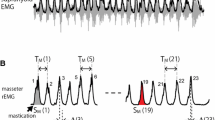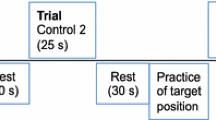Abstract
Exteroceptive jaw reflexes might play a role in normal functions of the mouth such as mastication. Until now these reflexes have only been studied under isometric conditions. The aim of this study was to compare exteroceptive reflexes in jaw muscle EMG during the closing phase of rhythmic open-close movements and clenching, at the same jaw gape and with similar muscle EMG. Reflexes consisting of successive waves of decreased and increased muscle activity (the Q, R, S and T waves of the post-stimulus electromyographic complex (PSEC)), evoked by light noxious electrical stimulation of the vermillion border of the lower lip, were recorded from the jaw closing muscles of 17 subjects. Differences between the two tasks occurred in two phases of the PSEC: (1) in an early phase, around the R wave, there was significantly less EMG during jaw closing (mean EMG ratio between jaw-closing and clenching 0.71), and (2) in a late phase, around the transition between the S to the T wave, there was significantly more EMG during jaw closing (mean EMG ratio: 1.40). The decrease in EMG activity around the R wave during jaw closing may be due to a change in reflex sensitivity at an interneuron level. The increase in EMG activity around the transition between the S and T waves during jaw closing might, at least in part, be due to a proprioceptive stretch reflex. This reflex is mediated by muscles spindles that are activated by the deceleration of the jaw evoked by the lip stimulus. The finding of inhibitory reflex mechanisms that predominate more during rhythmic jaw movements than during clenching in an early phase of the PSEC might be related to protecting oral tissues from trauma when the jaw is closing with potentially a large muscle force. In contrast, when food is held between the teeth, a possible inhibitory influence of light noxious stimuli is diminished.




Similar content being viewed by others
References
Abbink JH, van der Bilt A, Bosman F, van der Glas HW (1998) A comparison of jaw-opener and jaw-closer muscle activity in humans to overcome an external force counteracting jaw movement. Exp Brain Res 118:269–278
Brinkworth RSA, Türker KS, Savundra AW (2003) Response of human jaw muscles to axial stimulation of the incisor. J Physiol 547:233–245
Cadden SW, Newton JP (1988) A comparison of reflex depressions of activity in jaw-closing muscles evoked by intra- and peri-oral stimuli in man. Arch Oral Biol 33:863–869
Cadden SW, van der Glas HW, Lobbezoo F, van der Bilt A (1996) The influence of attentional factors on short- and long-latency reflexes in man. Arch Oral Biol 41:995–998
Chandler SH, Tal M (1986) The effects of brain stem transections on the neuronal networks responsible for rhythmical jaw muscle activity in the guinea pig. J Neurosci 6:1831–1842
Cruccu G, Agostino R, Inghilleri M, Manfredi M, Ongerboer de Visser BW (1989) The masseter inhibitory reflex is evoked by innocuous stimuli and mediated by A beta afferent fibres. Exp Brain Res 77:447–450
Dellow PG, Lund JP (1971) Evidence for central timing of rhythmical mastication. J Physiol 21:1–13
Desmedt JE, Godaux E (1979) Recruitment patterns of single motor units in the human masseter muscle during brisk clenching. Arch Oral Biol 24:171–178
Kroon GW, Naeije M, Hansson TL (1986) Electromyographic power-spectrum changes during repeated fatiguing contractions of the human masseter muscle. Arch Oral Biol 31:603–608
Lobbezoo F, van der Glas HW, Buchner R, van der Bilt A, Bosman F (1993) Jaw-jerk reflex activity in relation to various clenching tasks in man. Exp Brain Res 93:139–147
Louca C, Vidgeon SD, Cadden SW, Linden RWA (1998) The role of gingival mechanoreceptors in the reflex control of human jaw-closing muscles. Arch Oral Biol 43:55–63
Lund JP, Olsson KÅ (1983) The importance of reflexes and their control during jaw movement. Trends Neurosci 6:458–463
Lund JP, Rossignol S, Murakami T (1981) Interactions between the jaw-opening reflex and mastication. Can J Physiol Pharmacol 59:683–690
Mason AG, Scott BJJ, van der Glas HW, Linden RWA, Cadden SW (2002) Remote noxious stimuli modulate jaw reflexes evoked by activation of periodontal ligament mechanoreceptors in man. Exp Phys 87:699–706
Matthews B (1976) Reflexes elicitable from the jaw muscles in man. In: Anderson DJ, Matthews B (eds) Mastication. John Wright and Sons, Bristol, pp 139–146
Miles TS, Türker KS (1986) Does reflex inhibition of motor units follow the “size principle”? Exp Brain Res 62:443–445
Miles TS, Türker KS, Nordstrom MA (1987) Reflex responses of motor units in human masseter muscle to electrical stimulation of the lip. Exp Brain Res 65:331–336
Ongerboer de Visser BW, Cruccu G, Manfredi M, Koelman JH (1990) Effects of brainstem lesions on the masseter inhibitory reflex. Functional mechanisms of reflex pathways. Brain 113:781–792
Orchardson R, Cadden SW (1998) Mastication. In: Linden RWA (ed) The scientific basis of eating. pp 76–121
Ottenhoff FAM, van der Bilt A, van der Glas HW, Bosman F (1992) Peripherally induced and anticipating elevator muscle activity during simulated chewing in humans. J Neurophysiol 67:75–83
Scott BJ, Mason AG, Cadden SW (2002) Voluntary and reflex control of the human temporalis muscle. J Oral Rehabil 29:634–643
Türker KS (2002) Reflex control of human jaw muscles. Crit Rev Oral Biol Med 13:85–104
Türker KS, Miles TS (1985) The effect of stimulus intensity and gape on electrically-evoked jaw reflexes in man. Arch Oral Biol 30:621–626
Türker KS, Powers RK (2003) Estimation of postsynaptic potentials in rat hypoglossal motoneurones: insights for human work. J Physiol 551:419–431
Türker KS, Brodin P, Miles TS (1994) Reflex responses of motor units in human masseter muscle to mechanical stimulation of a tooth. Exp Brain Res 100:307–315
van der Bilt A, Ottenhoff FM, van der Glas HW, Bosman F, Abbink JH (1997) Modulation of the mandibular stretch reflex sensitivity during various phases of rhythmic open-close movements in humans. J Dent Res 76:839–847
van der Glas HW, van Steenberghe D (1981) Computer-based analysis of electromyographic silent period parameters in jaw muscles during clenching in man. Electromyogr Clin Neurophysiol 21:627–641
van der Glas HW, Weytjens JL, De Laat A, van Steenberghe D, Pardaens JL (1984) The influence of clenching level on the post-stimulus EMG complex, including silent periods, of the masseter muscles in man. Arch Oral Biol 29:51–58
van der Glas HW, de Laat A, van Steenberghe D (1985) Oral pressure receptors mediate a series of inhibitory and excitatory periods in the masseteric poststimulus EMG complex following tapping of a tooth in man. Brain Res 337:117–125
van der Glas HW, Abbink JH, van der Bilt A, Cadden SW (1995) Analysis of differences between conditioned and control reflex series in EMG recordings. J Neuroscience Methods 58:117–125
van der Glas HW, Cadden SW, Abbink JH (1999) Differentiating condition-induced facilitation, inhibition and disinhibition in a complex series of reflexes in an electromyogram. Brain Res Protoc 3:291–301
van der Glas HW, Cadden SW, van der Bilt A (2000) Mechanisms underlying the effects of remote noxious stimulation and mental activities on exteroceptive jaw reflexes in man. Pain 84:193–202
van Eijden TM, Brugman P, Weijs WA, Oosting J (1990) Coactivation of jaw muscles: recruitment order and level as a function of bite force direction and magnitude. J Biomech 23:475–485
Yang J, Türker KS (2001) Distribution of periodontal afferent input to motoneurons of human masseter. Arch Oral Biol 46:989–996
Yemm R (1972) The response of the masseter and temporal muscles following electrical stimulation of oral mucous membrane in man. Arch Oral Biol 17:23–33
Acknowledgements
This work was supported by the University Medical Center Utrecht and the Netherlands Institute for Dental Sciences.
Author information
Authors and Affiliations
Corresponding author
Rights and permissions
About this article
Cite this article
Hück, N.L., Abbink, J.H., Hoogenkamp, E. et al. Exteroceptive reflexes in jaw-closing muscle EMG during rhythmic jaw closing and clenching in man. Exp Brain Res 162, 230–238 (2005). https://doi.org/10.1007/s00221-004-2167-8
Received:
Accepted:
Published:
Issue Date:
DOI: https://doi.org/10.1007/s00221-004-2167-8




